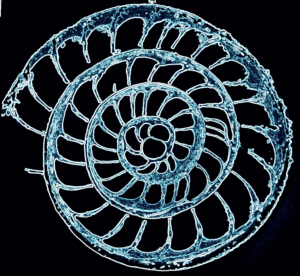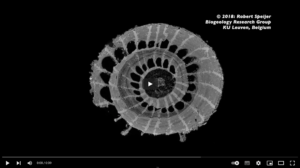Nummulites: small wonders of nature and distant memory of a subtropical northwestern Europe – Part 1
Robert Speijer is professor in geology and paleontology at KU Leuven (Belgium). With his research group he studies the interaction between climate change and the biosphere.

From the outside this object looks like a minute lens-shaped Scotch mint. The delicate spiral structure on the inside, however, reveals that it’s a product of mother nature, known as a nummulite. More specifically it’s the calcareous shell of a fossil specimen of Nummulites involutus and it was found in ancient marine clays exposed near the city of Kortrijk, Belgium.
What’s the big deal about an indistinct small fossil embedded in clay? Well, as indistinct as it may seem, It’s a relic from the time that global average temperatures were a whopping 10 to 15 degrees higher than today! This was the time of the early Eocene ‘hothouse’ between 56 and 50 million years ago and it was the last time that Earth experienced such high temperatures. Even at mid-latitude Belgium where the current average surface temperature is about 11 OC, in that period subtropical conditions with temperatures of 20 OC to almost 30 OC prevailed. But before delving further into the value of nummulites for exploring and understanding Earth’s past climate conditions, let’s first focus on the basics of these extraordinary fossils.
The internal cross section of the shell bears some superficial resemblance with the coiled shells of the well-known fossil ammonites. Yet, ammonites were mollusks and not at all related to nummulites. So what actually are nummulites? Nummulites (Family Nummulitidae) form a distinct diverse lineage within the single-celled Foraminifera (Phylum Retaria), which itself consists of thousands of different species living at the seafloor or as plankton at the surface of the seas and oceans. Foraminifera have an incredibly long and diverse fossil record, ranging back to the Early Cambrian, about 530 million years ago, but Inferences from molecular studies on modern foraminifera suggest that they may have evolved already some 700 million years ago, well before the rise of multicellular life. Whereas relatively few biologists study foraminifera, among paleontologists they are one of the most widely studied fossil groups. This is mainly because of their enormous abundance and diversity in the fossil record and their great potential to determine the age of the rocks in which they are embedded. Additionally, foraminifera provide a treasure throve for understanding climate and climate change of the past – more on that later.
So what’s so special about nummulites among the Foraminifera? Whereas most modern and fossil foraminifera species are not larger than a grain of sand (half a millimeter or less), this specimen is about 3 mm in diameter, which is huge for a single-celled organism, but actually quite small for an adult nummulite. Adult specimens of fossil nummulites species are commonly up to are several centimeters in diameter and the largest ones known reached sizes up to 18 cm in diameter!
A nummulite shell consists of a spiral of numerous chambers, starting with a tiny spherical, chamber (the so-called proloculus) sitting right in the middle of the shell. As the living cell grows within the shell, the increase in cell volume is accommodated for by extra chambers forming a flat spiral in which the later whorls fully overlap the earlier ones. In this way, only the last whorl can be observed from the outside. However, modern analytical techniques such as micro-CT scanning (like medical scanners) enables to reveal the internal structure of a nummulite in a non-destructive way. The image shows a virtual section right through the middle of the specimen, a so-called equatorial section. This section is part of virtual serial sectioning of the nummulites shown in this video:

https://www.youtube.com/watch?v=F9_-Eb34bsk
Note that in the video, the virtual sectioning starts at the top of the lens-shaped specimen and ends at the base of it.
The image shown here, shows the internal structure halfway the video sequence. Because the specimen is quite small, the internal structure of this nummulite is relatively simple, but in certain lineages among the nummulitids larger specimens may show a more complex structure, with multiple spirals entwined or with subdivisions of the chambers into smaller chamberlets.
You may wonder how a single-celled marine organism can grow a calcareous shell the size of an Olympic medal and larger. This is indeed quite a huge achievement, but nummulites cannot do this on their own. In their protoplasm, they carry numerous little helpers, generally known as photosymbionts. These are much smaller single-celled organisms, and include various kinds of autotrophic ‘algae’, such as diatoms and dinoflagellates. Like plants, these symbionts photosynthesize sugars for their cell growth and reproduction. This process also provides organic compounds as waste products and these are happily consumed by the nummulite, providing them with an extra food source. Since this concerns a symbiotic relationship, the nummulite shell provides something valuable in return for the ‘algae’, such as shelter from organisms preying on the ‘algae’. The photosymbionts live within the protoplasm in the chambers of the nummulite. The walls of these chambers consist of thin layers of calcite, which make the shells somewhat transparent. In that way, each chamber acts as a minute individual greenhouse and a single nummulite can be considered as a miniature natural equivalent of a modern glasshouse complex. Instead of growing crops, the nummulites grows ‘algae’ in its glasshouse.
The presence of sunlight is a key factor in the reproductive success of the photosymbionts and their nummulite hosts. Therefor nummulites live at the seafloor of shallow seas, where there is sufficient sunlight penetrating the shells, providing the energy for photosynthesis to the internal symbionts.
So far, I focused on some fascinating peculiarities of the giants amongst the tiny unicellular organisms in the sea. But a much bigger picture can also be drawn about nummulites. This relates to their preference to live exclusively in warm seas, much like reef-forming corals. In fact, geological data suggest that when shallow (sub)tropical seas became too hot, nummulites and other larger foraminifera thrived, whereas reef-forming corals almost completely vanished from the subtropics. This has occurred in the early Eocene around 56 million years ago and as will be discussed in part 2 of this topic, this may well happen again in the near future, if global temperature continues to increase at a high rate under enhanced greenhouse conditions. One the one hand, I will show that subtropical conditions that we know from the Caribbean region today were much more expanded during the early Eocene, even ranging into the North Sea Basin, which experienced average temperatures of 20 OC to almost 30 OC – compared with present-day 10 OC to 15 OC. On the other hand, it will become clear that low latitude coastal communities, particularly those of atolls, may suffer extra from global warming than from the globally rising sea-level alone. The vulnerability of many reef-building coral species to warming above ~30 OC is the key factor in this threatening problem.
Robert P. Speijer – Department of Earth & Environmental Sciences, KU Leuven, Belgium